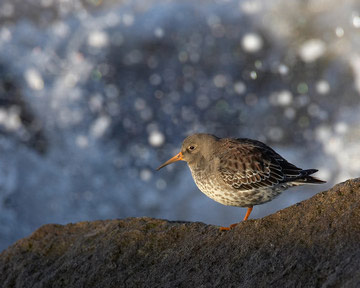Purple Sandpiper (Calidris maritima)

Purple Sandpiper © Richard Steel
Purple Sandpipers are the most northerly wintering waders in the world, with the birds in Britain at the southern edge of their range. Some remain to winter in their breeding areas in Greenland and Norway provided that the shore stays ice-free, and those that breed in Iceland are all resident. The sandpipers work up and down the tide edge, feeding throughout the daylight hours on molluscs, especially winkles, dogwhelks and mussels, with some crustaceans, small worms and algae. As a bird of rocky shores, Purple Sandpiper is never going to be widespread in Cheshire and Wirral, but this Atlas map shows all its usual haunts.
For as long as records have been kept, Hilbre has been their main site in Cheshire and Wirral. Counts of around twenty birds on the island were reported by Coward (1910) and Hardy (1941) but numbers then rose during the 1950s to between 30 and 50, with up to 100 present in the 1959/ 60 winter (Bell 1962). Further increases were implied by Craggs (1982) who stated that numbers varied, year to year, from 50-100. There can be considerable fluctuations but, according to figures in the annual county bird reports, since 1969/ 70 there does appear to have been a gradual reduction in the numbers wintering (November to February) at Hilbre, with the range of winter maxima for ten year periods being 40-83 birds in 1969/ 70-1978/ 79; 34-56 birds in 1979/ 80-1988/ 9; 32-55 birds in 1989/ 90-1998/ 99; and 24-45 birds in 1999/ 2000-2006/ 07, including 29 in 2004/ 05 as the maximum during this Atlas period. Is this another effect of a warming climate, allowing more birds to winter on or near their northern breeding grounds?
The Purple Sandpipers have been closely studied over the years by Hilbre Bird Observatory, with an early colour-ringing project – continuing to the present day – adding much to our knowledge of the species’ migration and site fidelity, birds being seen at the same site up to eight years after ringing (Craggs 1982). One of the first birds caught on Hilbre (7 February 1959) was later found in southern Greenland but their movements are complex and the biometrics of ringed birds have been important in sorting out the origins and wintering areas of the species. Even this is complicated, females being larger than males, but birds breeding in Norway are substantially smaller than those from other areas and these are mostly found in winter on the east coast of Britain. Longer-billed birds predominate in the north of Scotland and along the west coast of Britain, and it is now thought that they are from breeding grounds in the north of Canada. The Hilbre-ringed bird in Greenland, found there on 27 October 1964, was probably not a local breeding bird but a Canadian one on passage through Greenland (Migration Atlas). To confuse the picture further, Purple Sandpipers from different breeding areas probably intermix somewhat during winter, and two colour-ringed birds from Hilbre have been seen in Northumberland!
As well as the Hilbre flock, over the years Purple Sandpipers have been located at almost every suitably rocky spot around the north Wirral coast and most of them appear on this Atlas map for holding a bird or two at some stage during the three winters of this survey. The rocks between Caldy and Thurstaston, by West Kirby Marine Lake, Tanskey Rocks offshore from there, Red Rocks, the sea defences at Leasowe and New Brighton, New Brighton Marine Lake and the Mersey shore from Wallasey to New Ferry have all held birds on occasion. There are usually fewer than ten at these sites but 20 were counted at Red Rocks on 23 January 2003 and 14 were at Wallasey on 27 November 2004, with the largest flock away from Hilbre during this Atlas period 16 birds on a groyne at New Brighton on 30 December 2005.
This is clearly a fascinating bird whose small population wintering on Wirral deserves continued study.
Sponsored by Hilbre Bird Observatory and Ringing Station

